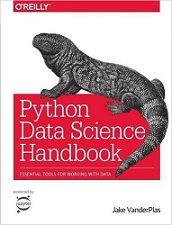
|
FreeComputerBooks.com
Links to Free Computer, Mathematics, Technical Books all over the World
|
|
- Title Python Data Science Handbook: Essential Tools for Working with Data
- Author(s) Jake VanderPlas
- Publisher: O'Reilly Media; 1 edition (December 10, 2016); eBook (2018. Updated continuously)
- License(s): Text Content: CC-BY-NC-ND; Source Code: MIT License
- Paperback 548 pages
- eBook HTML, PDF, and ePub
- Language: English
- ISBN-10: 1491912057
- ISBN-13: 978-1491912058
- Share This:

|
For many researchers, Python is a first-class tool mainly because of its libraries for storing, manipulating, and gaining insight from data. Several resources exist for individual pieces of this data science stack, but only with the Python Data Science Handbook do you get them all - IPython, NumPy, Pandas, Matplotlib, Scikit-Learn, and other related tools.
Working scientists and data crunchers familiar with reading and writing Python code will find this comprehensive desk reference ideal for tackling day-to-day issues: manipulating, transforming, and cleaning data; visualizing different types of data; and using data to build statistical or machine learning models. Quite simply, this is the must-have reference for scientific computing in Python.
- IPython and Jupyter: provide computational environments for data scientists using Python
- NumPy: includes the ndarray for efficient storage and manipulation of dense data arrays in Python
- Pandas: features the DataFrame for efficient storage and manipulation of labeled/columnar data in Python
- Matplotlib: includes capabilities for a flexible range of data visualizations in Python
- Scikit-Learn: for efficient and clean Python implementations of the most important and established machine learning algorithms
- Use statistical inference to answer questions about real-world data
- Jake VanderPlas is a long-time user and developer of the Python scientific stack. He currently works as an interdisciplinary research director at the University of Washington, conducts his own astronomy research, and spends time advising and consulting with local scientists from a wide range of fields.
- Programming/Engineering Handbooks
- Python Programming
- Data Science
- Data Analysis and Data Mining
- Big Data
- Machine Learning
- Books by O'Reilly®

- Python Data Science Handbook: Essential Tools for Working with Data (Jake VanderPlas)
- The Mirror Site (1) - PDF, ePub, etc.
- Book Homepage (Jupyter Notebooks, etc.)
-
 Introduction to Data Science Using Python (Afrand Agah)
Introduction to Data Science Using Python (Afrand Agah)
Dive into the transformative world of Data Science with this comprehensive guide, focusing on Python's application in data science rather than broad software development. Utilizes machine-learning and statistics to accomplish data-driven resolutions.
-
 Python for Data Analysis: Pandas, NumPy, and Jupyter
Python for Data Analysis: Pandas, NumPy, and Jupyter
The focus is specifically on Python programming, libraries, and tools as opposed to data analysis methodology. This is the Python programming you need for data analysis. You'll learn the latest versions of pandas, NumPy, and Jupyter in the process.
-
 Data Analysis with Python (Numpy, Matplotlib and Pandas)
Data Analysis with Python (Numpy, Matplotlib and Pandas)
Understand data analysis pipelines using machine learning algorithms and techniques with this practical guide, using Python. Equipped with the skills to prepare data for analysis and create meaningful data visualizations for forecasting values from data.
-
 Learning Pandas: Python for Data Munging, Analysis, Visualization
Learning Pandas: Python for Data Munging, Analysis, Visualization
This book is designed to bring developers and aspiring data scientists who are anxious to learn Pandas up to speed quickly. It covers the essential functionality. It includes many examples, graphics, code samples, and plots from real world examples.
-
 From Python to NumPy (Nicolas P. Rougier)
From Python to NumPy (Nicolas P. Rougier)
NumPy is one of the most important scientific computing libraries available for Python. This book teaches you how to achieve expert level competency to perform complex operations, with in-depth coverage of advanced concepts.
-
 Guide to NumPy (Travis E. Oliphant)
Guide to NumPy (Travis E. Oliphant)
This book is for programmers, scientists, or engineers, who have basic Python knowledge and would like to be able to do numerical computations with Python. It will give you a solid foundation in NumPy arrays and universal functions.
-
 NumPy Tutorials (Usman Malik, Anne Bonner, et al)
NumPy Tutorials (Usman Malik, Anne Bonner, et al)
They provide everything you need to know to get started with NumPy. They also explain the basics of NumPy such as its architecture and environment, discusses the various array functions, types of indexing, etc. With examples for better understanding.
-
 Scipy Lecture Notes (Emmanuelle Gouillart, et al)
Scipy Lecture Notes (Emmanuelle Gouillart, et al)
This book is the teaching material on the scientific Python ecosystem, a quick introduction to central tools and techniques. It is for programmers from beginner to expert. Work on real-world problems with SciPy, NumPy, Pandas, scikit-image, and other Python libraries.
-
 SciPy Programming Succinctly (James McCaffrey)
SciPy Programming Succinctly (James McCaffrey)
This book offers readers a quick, thorough grounding in knowledge of the Python open source extension SciPy. The SciPy library, accompanied by its interdependent NumPy, offers Python programmers advanced functions that work with arrays and matrices.





